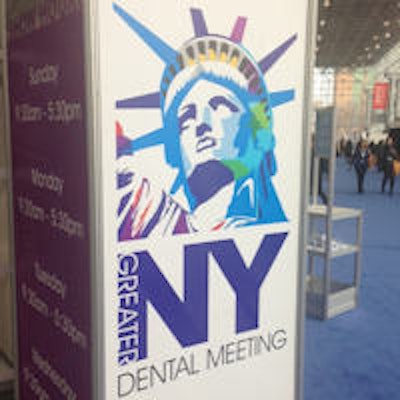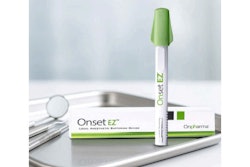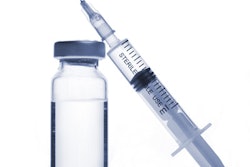
Mic Falkel, DDS, has spent a considerable amount of time studying anesthesia. Yet the presenter at the recent Greater New York Dental Meeting was humbled by a problem he encountered while administering local anesthesia that most dentists are likely to have encountered themselves.
"When do we expect local anesthetics to start?" Dr. Falkel asked during his presentation, "Local Anesthesia -- Technique, Anatomy, and Physiology in the Digital Era." Then he answered his own question: "An average of three to five minutes for infiltrations and five to seven minutes for [inferior alveolar nerve] blocks."
But the local anesthesia onset times that he encountered did not jive with those averages. "These numbers are common and made me feel like I was doing something wrong," said Dr. Falkel, a clinician at the Monterey Peninsula Dental Group and founder and chief medical officer of Onpharma. "So I looked at where I got these numbers in [Stanley Malamed, DDS]'s textbooks. When I found them, there was no reference to the source of those numbers."
“Teeth are the hardest part of the body to anesthetize.”
Not content with the dead end, Dr. Falkel sought out Dr. Malamed to learn about the source of these numbers. "I had to corner Dr. Malamed and asked where he got the numbers. He said he got them from the previous author." That author has passed on, but still the numbers still didn't have a reference. And so on.
"They were written in stone, it seemed, going back to Moses' time," Dr. Falkel said. "What do these numbers mean? They actually reference the start of soft-tissue analgesia."
Dentists who begin treatment immediately after a patient signals that they feel something may encounter what Dr. Falkel described as the "worst failure of local anesthesia in dentistry."
"The patient thinks they feel numb. I've stabbed them so I think they're numb," he explained. "But as soon as you hit dentin, they jump. Everyone's day is ruined. The assistant's flustered, the dentist is sweating, and the patient tense for the rest of the day."
Testing for numbness
When confirming analgesia, a sharp explorer is not an ideal tool. Instead, Dr. Falkel recommended an electric pulp tester or Endo-Ice. The former runs a current through the tooth. "If you can get to 80 on this device, the tooth is nonvital or the anesthesia worked," he said. "With Endo-Ice, don't tell the patient that it will feel cold. Just ask if there's any sensation after you put it right on the cervical aspect of the tooth. If it can stay, they are numb."
So when should these tests take place? One study found 95% success after a 45-minute waiting period(Journal of Endodontics, July 2005; Vol. 31:7, pp. 499-503). "I don't know about you, but I don't have that time," Dr. Falkel said. He then described situations in which a practitioner thinks the anesthesia hasn't worked and sends the patient home -- only to get a call 45 minutes later when they're numb.
"The take-home from that situation and the study is that the problem is time, not technique," Dr. Falkel explained.
Most practitioners are aware of this, subconsciously or otherwise, because they leave the operatory after giving an injection. But for how long? "We've polled dentists and the No. 1 answer is 10 minutes; the No. 2 response is 15 minutes," Dr. Falkel said. "We also polled 200 dental assistants. They all said, 'Yes, the dentist leaves for 15 minutes,' while the No. 2 response was 10 minutes."
In his opinion, dentists are hedging their bets and waiting longer than the textbook's numbers. "We all leave, but what are we waiting for?"
In the local anesthesia studies he examined, a curve developed in onset times. "It turns out that 10 minutes is the knee in the curve," Dr. Falkel said. At 10 minutes, 58% of the studies' participants were numb, and the percentage increases to 65% after 15 minutes. "So if they're not stone-cold numb after 15 minutes, don't be surprised," he added. "We weren't taught to manage anesthetic latency in our practices, so we're working off of faith. We live with the curve whether we realized it or not."
Escaping the curve
A buffered anesthetic can help reduce onset times, according to the studies that Dr. Falkel examined. In one study examining the effectiveness of Onset, a local anesthetic buffering system made by his company, only 12% of the control anesthetic was effective in under two minutes, compared with 71% of the Onset group(Compendium, Feb 2013; Vol. 34: Spec No 1, pp. 10-20). There was also less injection pain with Onset: 6% reported a 0 on a visual analogue scale (VAS) in the control group, while 44% did with Onset. And 72% said Onset was the more comfortable injection.
"Now, you can make same decision at two minutes that you could at 15 minutes," Dr. Falkel said. "So you're able to proceed [after two minutes] over 70% of the time, or the odds are you need to do something else."
He urged clinicians to evaluate the evidence of buffering local anesthetics. In his experience, the studies show that buffering is safe and effective. "Some results are inconsistent, but buffering studies have often achieved exceptional results," he added.
While dentists may have experienced frustration in the past with what may be unrealistic expectations for local anesthesia times, Dr. Falkel gave his colleagues an unreserved vote of confidence. "We are the best anesthesiologists in the world because teeth are the hardest part of the body to anesthetize," he said. "They're encased in the hardest tissue in the body.
"Take pride in that," he said.
Disclosure
Dr. Falkel disclosed that the Greater New York Dental Meeting session was sponsored by Onpharma.



















